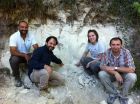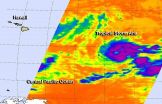(Press-News.org) ATHENS, Ohio (Oct. 14, 2014)—It's been millions of years since T. rex took its last breath, but a team led by Ohio University scientists is breathing life back into dinosaurs using high-powered computer simulations to model airflow through dinosaur snouts. The research has important implications for how dinosaurs used their noses to not only breathe but to enhance the sense of smell and cool their brains.
"Dinosaurs were pretty 'nosy' animals," said Ohio University doctoral student Jason Bourke, lead author of the new study published today in the Anatomical Record. "Figuring out what's going on in their complicated snouts is challenging because noses have so many different functions. And it doesn't help that all the delicate soft tissues rotted away millions of years ago."
To restore what time had stripped away, the team turned to the modern-day relatives of dinosaurs—birds, crocodiles and lizards—to provide clues. "We'll do whatever it takes," said Lawrence Witmer, professor in the Ohio University Heritage College of Osteopathic Medicine and principal investigator on the National Science Foundation's Visible Interactive Dinosaur Project, which funded much of the research. "We did lots of dissections, blood-vessel injections and CT scanning, but a major new tool was 3D computer simulation of airflow."
Bourke drew from a branch of engineering called computational fluid dynamics, an approach commonly used in the aerospace industry and medicine, to model how air flowed through the noses of modern-day dinosaur relatives such as ostriches and alligators. "Once we got a handle on how animals today breathe," Bourke said, "the tricky part was finding a good candidate among dinosaurs to test our methods."
The dinosaurs that best fit the bill were the pachycephalosaurs, or "pachys," a group of plant-eating dinosaurs best known for the several-inch-thick bone on the tops of their skulls which is thought to have served both as a visual display and as protection for head-butting behaviors like those of modern-day rams. It turns out that building all that extra skull bone resulted in ossifying soft tissues in other areas of the body—such as the nose.
"When we cleaned up the fossil skull of Sphaerotholus, a pachy from North Dakota, we didn't expect to see these delicate scrolls of bone in the nasal region. We knew they must be nasal turbinates," said Emma Schachner, a co-author on the study from Louisiana State University who, along with Tyler Lyson of the Denver Museum of Nature and Science, studied some of the fossil specimens used in the study. Similar structures were found in a different pachy species from Canada called Stegoceras by co-author Phil Bell from the University of New England in Australia.
The first nasal turbinates to be discovered were in the back part of the nasal cavity, called the olfactory chamber, where smelling takes place. Work by Witmer and Ohio University researcher Ryan Ridgely on CT scans of Stegoceras showed that the olfactory region of the brain was quite large, which, along with the large olfactory turbinates, suggested that Stegoceras had a good sense of smell.
But when Bourke ran his airflow simulation analyses, the inspired air bypassed the olfactory chamber. "It made no sense," Bourke said. "Stegoceras obviously had a pretty decent sense of smell, but the odors weren't reaching where they needed to go. We obviously were missing a piece of the puzzle."
That missing puzzle piece was hinted at by a long bony ridge on the wall of the front of the nasal cavity. In the modern-day relatives of dinosaurs, cartilaginous nasal turbinates often attach to such ridges, suggesting to the team that pachys may have had turbinates in the front, respiratory part of the nasal cavity.
When Bourke digitally inserted respiratory turbinates of different shapes—whether it was the scrolled turbinate of a turkey or the branched turbinate of an ostrich—the computer airflow simulations started to make more sense.
"Some of the restored airflow patterns now carried odors to the olfactory region," said Bourke. "We don't really know what the exact shape of the respiratory turbinate was in Stegoceras, but we know some kind of baffle had to be there. We have the smoking gun of the bony ridge on the fossil, and the airflow analyses show that attaching some kind of turbinate produced the only airflow that made any real biological sense."
Why have turbinates at all? Some scientists had previously suggested that warm-blooded animals such as birds and mammals have turbinates to act like condensers to save water that might have been lost during exhalation. That may be true in some cases, but this new research suggests that turbinates also have important functions as baffles to direct air to the olfactory region. But they might also play another critical role—cooling the brain.
Study co-author Ruger Porter, another Ohio University doctoral student, has been studying the pattern of blood flow in pachycephalosaurs and other dinosaurs, as well as their modern-day relatives. "The fossil evidence suggests that Stegoceras was basically similar to an ostrich or an alligator," Porter said. "Hot arterial blood from the body was cooled as it passed over the respiratory turbinates, and then that cooled venous blood returned to the brain. It may not have been much of a brain, but you don't want it cooked!"
Now that Bourke and his team have worked out nasal airflow in the "easy case" of Stegoceras, the team is turning its attention to trickier dinosaur cases, such the crazy-straw airways of armored ankylosaurs and duckbilled hadrosaurs.
INFORMATION:
The research was funded by National Science Foundation grants to Witmer and Ridgely and a fellowship to Bourke, as well as by the Ohio University Heritage College of Osteopathic Medicine.
Editors: Images, animations, fact sheets and related information can be viewed on the WitmerLab site: http://www.oucom.ohiou.edu/dbms-witmer/pachy_airflow.htm.
Contact information: (all Eastern Daylight Time):
1. Jason Bourke, 740-818-7503, jb513009@ohio.edu [lead author]
2. Lawrence Witmer, 740-591-7712, witmerL@ohio.edu [co-author]
3. Andrea Gibson, 740-597-2166, gibsona@ohio.edu [Director of Research Communications]
Dinosaur breathing study shows that noses enhanced smelling and cooled brain
Researchers discover preserved nasal features in bony-headed dinosaur fossils
2014-10-14
ELSE PRESS RELEASES FROM THIS DATE:
Mars One -- and done?
2014-10-14
In 2012, the "Mars One" project, led by a Dutch nonprofit, announced plans to establish the first human colony on the Red Planet by 2025. The mission would initially send four astronauts on a one-way trip to Mars, where they would spend the rest of their lives building the first permanent human settlement.
It's a bold vision — particularly since Mars One claims that the entire mission can be built upon technologies that already exist. As its website states, establishing humans on Mars would be "the next giant leap for mankind."
But engineers at MIT say the project ...
New sequencing reveals genetic history of tomatoes
2014-10-14
This week, an international team of researchers, led by the Chinese Academy of Agricultural Sciences in Beijing, published in the journal Nature Genetics a brief genomic history of tomato breeding, based on sequencing of 360 varieties of the tomato plant.
The C.M. Rick Tomato Genetics Resource Center at UC Davis played an important role in this study by providing seed of both cultivated tomato varieties and related wild species.
This study, which builds on the first tomato genome sequence completed just two years ago, shows in great detail how the processes of early ...
Photopharmacology: Optical control of insulin secretion
2014-10-14
Researchers at Ludwig-Maximilians-Universitaet (LMU) in Munich have chemically modified an anti-diabetic agent so as to make its action dependent on light. The resulting prototype compound, termed JB253, induces release of insulin only when pancreas cells are exposed to blue light.
Synthetic, light-sensitive, molecular switches can be utilized to control biochemical signaling processes in living cells. In a new study, a research team led by LMU Professor Dirk Trauner (Chemical Biology and Genetics) and his colleague Johannes Broichhagen, in collaboration with Prof. Guy ...
Earth's magnetic field could flip within a human lifetime
2014-10-14
Imagine the world waking up one morning to discover that all compasses pointed south instead of north.
It's not as bizarre as it sounds. Earth's magnetic field has flipped – though not overnight – many times throughout the planet's history. Its dipole magnetic field, like that of a bar magnet, remains about the same intensity for thousands to millions of years, but for incompletely known reasons it occasionally weakens and, presumably over a few thousand years, reverses direction.
Now, a new study by a team of scientists from Italy, France, Columbia University ...
House fly genome reveals expanded immune system
2014-10-14
ITHACA, N.Y. – Scientists have sequenced the house fly genome for the first time, revealing robust immune genes, as one might expect from an insect that thrives in pathogen-rich dung piles and garbage heaps.
The research, published Oct. 14 in the journal Genome Biology, will increase understanding of house fly genetics and biology and of how flies quickly adapt to resist insecticides, which could lead to novel control methods.
Adult house flies (Musca domestica) carry and transmit more than 100 human and animal diseases, including salmonellosis, anthrax, typhoid ...
NASA's Aqua satellite spots Central Pacific's Tropical Storm Ana
2014-10-14
NASA's Aqua satellite passed over Tropical Storm Ana on Monday, Oct. 13 after it formed in the Central Pacific Ocean.
Ana formed on Oct. 13 at 5 p.m. EDT (11 a.m. HST) as Tropical Depression 2-C, about 920 miles (1,480 km) east-southeast of Hilo, Hawaii. By 9 p.m. EDT that day, the depression had strengthened into Tropical Depression Ana.
NASA's Aqua satellite passed over Tropical Storm Ana on Monday, Oct. 13 at 11:11 UTC (7:11 a.m. EDT) and the Atmospheric Infrared Sounder or AIRS instrument gathered infrared data that showed some strong thunderstorms and cold cloud ...
1934 drought was worst of the last millennium, study finds
2014-10-14
WASHINGTON, DC— The 1934 drought was by far the most intense and far-reaching drought of the last 1,000 years in North America, and was caused in part by an atmospheric phenomenon that may have also led to the current drought in California, according to a new study.
New research finds that the extent of the 1934 drought was approximately seven times larger than droughts of comparable intensity that struck North America between 1000 A.D. and 2005, and nearly 30 percent worse than the next most severe drought that struck the continent in 1580.
"We noticed that ...
Building a bridge from basic botany to applied agriculture
2014-10-14
One of the planet's leading questions is how to produce enough food to feed the world in an increasingly variable climate. The Food and Agriculture Organization of the United Nations predicts that food production must rise 70% over the next 40 years to feed a growing global population, and plants are one major component of the necessary rise in food production. Plants—grains, cereals, fruits, vegetables, and more—feed humans directly and indirectly by supporting livestock. Current research must tap into our knowledge of how plants work to develop more efficient ...
This week from AGU: Glacier health check, world ocean atlas, liquid brines on Mars
2014-10-14
From AGU's blogs: Health check reveals how glacier is declining due to warming climate http://blogs.agu.org/geospace/2014/10/13/health-check-reveals-glacier-declining-due-warming-climate/
Researchers from the British Geological Survey have taken the very first comprehensive health check of a rapidly melting glacier. Their latest study reveals that their icy patient, the Falljökull glacier in southeast Iceland, has been dramatically declining as it tries to adjust to recent changes in the climate.
The new findings on Falljökull show unhealthy changes in the ...
Social trust eroded in Chinese product-tampering incident
2014-10-14
URBANA, Ill. – For about a decade, Chinese consumers weren't getting what they paid for when they purchased Wuchang, a special brand of gourmet rice that has a peculiar scent. The quality was being diluted when less expensive rice was aromatized, added to the packages of the high-quality rice, and sold at the premium price. Researchers at the University of Illinois studied how the tampering scandal affected the public's perception of risk and their subsequent behavior.
Because public anxiety over the fake rice issue was more pronounced in urban districts, the researchers ...
LAST 30 PRESS RELEASES:
Stardust study resets how life’s atoms spread through space
Practical education: Clinical scenario-based program development
The impact of family dynamics on eating behaviour – how going home for Christmas can change how you eat
Tracing the quick synthesis of an industrially important catalyst
New software sheds light on cancer’s hidden genetic networks
UT Health San Antonio awarded $3 million in CPRIT grants to bolster cancer research and prevention efforts in South Texas
Third symposium spotlights global challenge of new contaminants in China’s fight against pollution
From straw to soil harmony: International team reveals how biochar supercharges carbon-smart farming
Myeloma: How AI is redrawing the map of cancer care
Manhattan E. Charurat, Ph.D., MHS invested as the Homer and Martha Gudelsky Distinguished Professor in Medicine at the University of Maryland School of Medicine
Insilico Medicine’s Pharma.AI Q4 Winter Launch Recap: Revolutionizing drug discovery with cutting-edge AI innovations, accelerating the path to pharmaceutical superintelligence
Nanoplastics have diet-dependent impacts on digestive system health
Brain neuron death occurs throughout life and increases with age, a natural human protein drug may halt neuron death in Alzheimer’s disease
SPIE and CLP announce the recipients of the 2025 Advanced Photonics Young Innovator Award
Lessons from the Caldor Fire’s Christmas Valley ‘Miracle’
Ant societies rose by trading individual protection for collective power
Research reveals how ancient viral DNA shapes early embryonic development
A molecular gatekeeper that controls protein synthesis
New ‘cloaking device’ concept to shield sensitive tech from magnetic fields
Researchers show impact of mountain building and climate change on alpine biodiversity
Study models the transition from Neanderthals to modern humans in Europe
University of Phoenix College of Doctoral Studies releases white paper on AI-driven skilling to reduce burnout and restore worker autonomy
AIs fail at the game of visual “telephone”
The levers for a sustainable food system
Potential changes in US homelessness by ending federal support for housing first programs
Vulnerability of large language models to prompt injection when providing medical advice
Researchers develop new system for high-energy-density, long-life, multi-electron transfer bromine-based flow batteries
Ending federal support for housing first programs could increase U.S. homelessness by 5% in one year, new JAMA study finds
New research uncovers molecular ‘safety switch’ shielding cancers from immune attack
Bacteria resisting viral infection can still sink carbon to ocean floor
[Press-News.org] Dinosaur breathing study shows that noses enhanced smelling and cooled brainResearchers discover preserved nasal features in bony-headed dinosaur fossils



